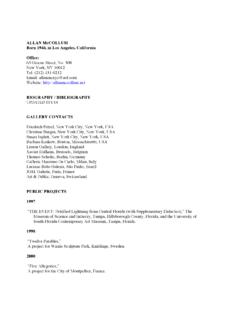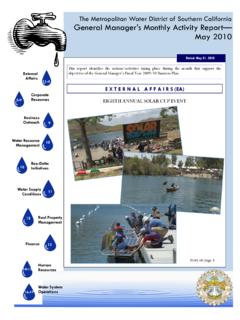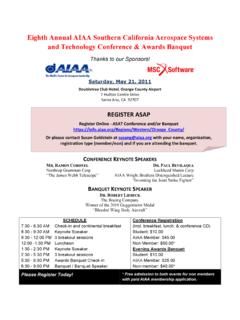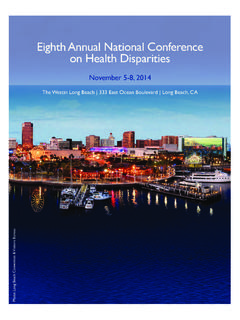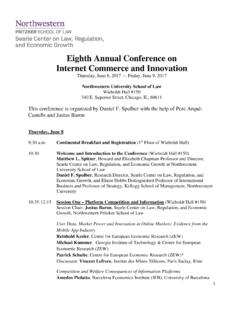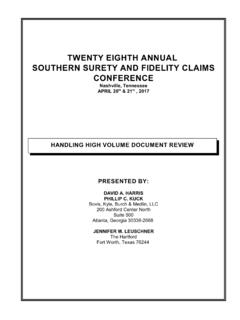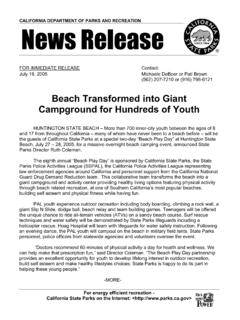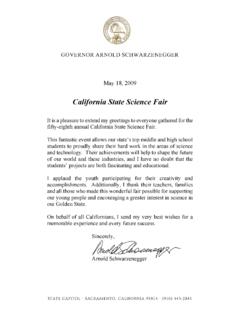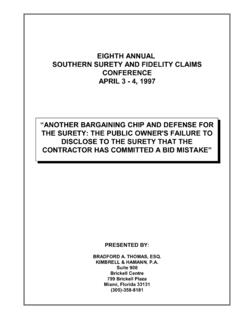Transcription of THE 788th MEETING OF THE MINERALOGICAL SOCIETY OF …
1 3/22/17, 1(14 PMOctober 2003 Page 1 of 7 788th MEETINGOFTHE MINERALOGICAL SOCIETYOF southern CALIFORNIA7:30 , Friday October 10, 2003 Building E, Room 220 Pasadena City CollegePasadena, CaliforniaFeaturing a Talk byBob ReynoldsonTurquoise from the Mojave Desert:a gemstone mined for the past 1,000 ProgramOur October Speaker will be Bob Reynolds, and his subject will be Turquoise fromthe Mojave Desert: a gemstone mined for the past 1,000 Reynolds is a graduate of Pasadena High School and Pasadena CommunityCollege which greatly influenced his career in mineralogy and paleontology.)
2 Following graduation from the University of california , Riverside, he spent morethan 30 years as Curator of Earth Sciences at the San Bernardino County Museumin Redlands, california . During that time he developed volunteer programs inmineralogy, resulting in the informal but very active "Museum Mineral Group" whoassisted with a wide variety of curatorial and educational activities, includingcreating displays for the MSSC show and the Tucson Gem and Mineral show. is presently the Project Manager, Paleontology, with LSA Associates inRiverside. He continues to work with members of the MSSC and the SouthernCalifornia Chapter of Friends of Mineralogy in mineralogy education and Blind Springs Silver District3/22/17, 1(14 PMOctober 2003 Page 2 of 7 Walt MargerumMost of us have heard of Calico, Cerro Gordo, and Darwin, but may not be aware ofthe Blind Springs Hill district near Benton Hot Springs in Mono County.)
3 This is oneof the earliest silver mining districts in california , and one of the few to be minedprimarily for antimonial silver A. Whiting gives the following description of the district. Blind Spring Hill, inwhich the Comanche, Wai Wera, Cornucopia, Borasca, and other mines occur, isabout six miles from north to south by about three miles from east to west. Itseastern flank is so abrupt as to be precipitous in many places, particularly on itsnorthern end, and down to its very foot sweeps a broad talus from the western flankof the White Mountains, across the floor of the narrow Blind Springs Valley, throughwhich the Carson and Colorado Railroad now runs.
4 The western slope of BlindSpring Hill has a much less abrupt descent, and the approach to its mines is fromthis side. Viewed from the west the crest of this mountain falls by the gentlest slopeto the north until its contour there merges grace-fully into the plain at the northwestbase of the White Mountains. At its southern end this hill falls very much morerapidly down to Yellow Jacket mining district was organized early in 1864; following the discovery of theCornucopia, Diana (now Wai Wera), and Comanche veins, within a few days of oneanother, and in the order named; and soon, as usual, the entire mountain wasspeedily covered by describes the mineralogy as follows: An examination at Benton of twocollections of ores from all of its out-lying districts showed a marked uniformity inthe prevailing character of their mineral constituents.
5 They were all essentially moreor less complex associations of antimonial ores of copper, lead, and silver, with,usually, scarcely more than traces of minerals observed in the ores of these two collections were pyrite, chalcopyrite,bornite, gray copper ore (tetrahedrite), sphalerite, galenite, argentite, pyrargyrite,stephanite, kerargyrite, native silver, magnetite, partzite, hematite, anglesite, andcerussite. Only a small number of these, of course, were observed in any oneassociation, the prevailing minerals being, generally, the sulphurets of iron, lead,and zinc, with antimonial silver minerals.
6 Native copper was an occasionaloccurrence. In the deeper mines of Blind Spring Hill, antimonial gray copper ore isreported to have replaced the partzite below the so called water Blind Springs district is the type locality for partzite named for August F. an expert assayer and mineralogist. He also founded the town of Partzwickwhich does not appear on any current maps. Remi Nadeau indicates that all thebuildings in Partzwick were dismantled and moved to Benton Hot Springs by is a secondary mineral of the stiboconite group with the formula Cu 2Sb2(O,OH)7.
7 It ranges in color from olive-green to blackish-green, and tarnishesblack. It is the main reason I went to the , 1(14 PMOctober 2003 Page 3 of 7 Blind Springs Hill road and minesThere are two roads, and I use that term loosely, into the area. The northern one iswashed out and is impassable. Even a trail bike would have to be carried overseveral stretches. The southern route is passable by high clearance 4WD vehicle ifyou do not mind possible damage to your vehicle. Roger Mitchell gives parts of thesouthern route a Class IV rating. For this rating he states If you are not a skillfuland experienced off-road driver the body of your vehicle may suffer a little.)
8 I havehiked this route and agree with his assessment. If you want to hike into the area the northern route is best. The distance is Km (8000 ft.) with an altitude gain of 280 meters (920 ft.). The final elevation isabout 2000 meters (6000 ft.). My search for partzite had uncertain Success. I found a small amount of ayellowish mineral that meets the description, but not enough to confirm its identity. Idid find galena, cerussite, tetrahedrite, pyrite, siderite, and chrysocolla. None ofthem spectacular. It is not surprising that I did not find any silver minerals since thedumps have been reworked several times by what were called chloriders.
9 Tuckerand Sampson report that a 4320 ft tunnel, the Ross, was driven west from LastChance Canyon, and intersected the Kerrick vein at 4116 feet. As far as I can tellthe last mining was done in the 1950 , Roger (2003) Inyo-Mono SUV Trails ; Track and Trail Publications, pp 93-3/22/17, 1(14 PMOctober 2003 Page 4 of 7 , Remi (1999) The Silver Seekers ; Crest Publishers, pp 65-85 Tucker, W. B. and Sampson R. J. (1940), Current Mining Activity in SouthernCalifornia ; california Journal of Mines and Geology, Volume 36 Number 1, pp 45-46 Whiting H. A.)
10 (1888) Mono County, Benton Mining Districts ; california StateMining Bureau Eighth annual Report of the State Mineralogist, pp 376-382An Invitation to Learn about the Carlin Gold BoomThe Branner Club, an informal group of southern california geologists, invitesMSSC members to attend it's next MEETING at Caltech on Monday, November 10. The featured speaker will be Dr. Jonathan G. Price, State Geologist and Director,Nevada Bureau of Mines and Geology. The title of his talk is "Carlin and theBiggest Gold-Mining Boom in American History." In 2002 the Carlin trend, a narrowbelt of gold deposits in northeastern Nevada, reached a landmark in production, 50million troy ounces of gold.
